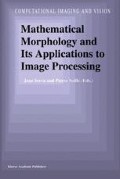Abstract
This paper presents a segmentation algorithm for image sequences oriented to very low bit rate video coding applications. The main issue of the process is to get a segmentation that is coherent in time and that solves the region correspondence problem. The morphological approach to this problem uses the temporal connectivity of the objects to establish the concept of ”3D objects” and track the evolution of the regions in time. In this paper we propose a morphological time-recursive segmentation which introduces motion estimation within the segmentation process in order to better account for large motion and improve the tracking of objects.
Access this chapter
Tax calculation will be finalised at checkout
Purchases are for personal use only
Preview
Unable to display preview. Download preview PDF.
References
M. Pardas, P. Salembier (1994), “3D Morphological Segmentation and Motion Estimation for Image Sequences”, in EURASIP Signal Processing, Special Issue on Mathematical Morphology, Vol. 38, N. 2, September 1994.
P. Willemin, T. Reed and M. Kunt (1991), “Image sequences coding by split and merge”, IEEE Trans. on Communications, Vol. 39, No12, pp 1845–1855.
M. Pardas, P. Salembier (1994), “Time-recursive Segmentation of Image Sequences”, in Proc. of EUSIPCO-94, Edinburgh, September 1994.
P. Salembier (1994), “ Morphological multiscale segmentation for image coding”, in EURASIP Signal Processing (Special issue on Nonlinear Signal Processing), Vol 39, No 2, December 1994.
P. Salembier (1993), “Multi-criterion segmentation for image coding”, Proc. of International Workshop on Mathematical Morphology and Its Applications to Signal Processing, Barcelona, pp.40–45.
J. Serra and P. Salembier (1993), “Connected operators and Pyramids”, Proc. of SPIE Image Algebra and Mathematical Morphololgy, San Diego, Vol. 2030, pp. 65–76, 1993.
F. Meyer and S. Beucher (1990), “Morphological Segmentation”, Journal of Visual Communication and Image Representation, Vol. 1, No.1 pp. 21–46.
F. Meyer (1992), “Color Image Segmentation”, Proc. 4th International Conference on Image Processing and its Applications, Maastricht, 1992, pp. 303–307.
J.R. Jain and A.K. Jain (1981), “Displacement measurement and its application in interframe coding”, IEEE Trans, COM-29, (12), 1981, pp. 1799–1808.
M. Pardas, P. Salembier (1994), “Motion and region overlapping estimation for segmentation-based video coding”, submitted to First IEEE International Conference on Image Processing,Austin, Texas, November 94.
Author information
Authors and Affiliations
Editor information
Editors and Affiliations
Rights and permissions
Copyright information
© 1994 Springer Science+Business Media Dordrecht
About this chapter
Cite this chapter
Pardas, M., Salembier, P. (1994). Joint Region and Motion Estimation with Morphological Tools. In: Serra, J., Soille, P. (eds) Mathematical Morphology and Its Applications to Image Processing. Computational Imaging and Vision, vol 2. Springer, Dordrecht. https://doi.org/10.1007/978-94-011-1040-2_13
Download citation
DOI: https://doi.org/10.1007/978-94-011-1040-2_13
Publisher Name: Springer, Dordrecht
Print ISBN: 978-94-010-4453-0
Online ISBN: 978-94-011-1040-2
eBook Packages: Springer Book Archive

